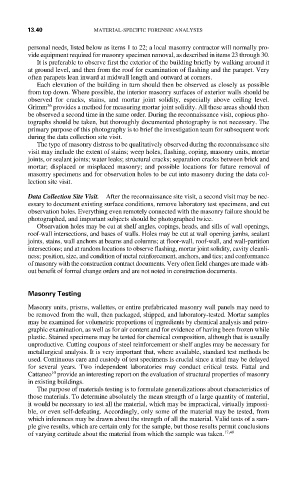Page 495 - Forensic Structural Engineering Handbook
P. 495
13.40 MATERIAL-SPECIFIC FORENSIC ANALYSES
personal needs, listed below as items 1 to 22; a local masonry contractor will normally pro-
vide equipment required for masonry specimen removal, as described in items 23 through 30.
It is preferable to observe first the exterior of the building briefly by walking around it
at ground level, and then from the roof for examination of flashing and the parapet. Very
often parapets lean inward at midwall length and outward at corners.
Each elevation of the building in turn should then be observed as closely as possible
from top down. Where possible, the interior masonry surfaces of exterior walls should be
observed for cracks, stains, and mortar joint solidity, especially above ceiling level.
36
Grimm provides a method for measuring mortar joint solidity. All these areas should then
be observed a second time in the same order. During the reconnaissance visit, copious pho-
tographs should be taken, but thoroughly documented photography is not necessary. The
primary purpose of this photography is to brief the investigation team for subsequent work
during the data collection site visit.
The type of masonry distress to be qualitatively observed during the reconnaissance site
visit may include the extent of stains; weep holes, flashing, coping, masonry units, mortar
joints, or sealant joints; water leaks; structural cracks; separation cracks between brick and
mortar; displaced or misplaced masonry; and possible locations for future removal of
masonry specimens and for observation holes to be cut into masonry during the data col-
lection site visit.
Data Collection Site Visit. After the reconnaissance site visit, a second visit may be nec-
essary to document existing surface conditions, remove laboratory test specimens, and cut
observation holes. Everything even remotely connected with the masonry failure should be
photographed, and important subjects should be photographed twice.
Observation holes may be cut at shelf angles, copings, heads, and sills of wall openings,
roof-wall intersections, and bases of walls. Holes may be cut at wall opening jambs, sealant
joints, stains, wall anchors at beams and columns; at floor-wall, roof-wall, and wall-partition
intersections; and at random locations to observe flashing, mortar joint solidity, cavity cleanli-
ness; position, size, and condition of metal reinforcement, anchors, and ties; and conformance
of masonry with the construction contract documents. Very often field changes are made with-
out benefit of formal change orders and are not noted in construction documents.
Masonry Testing
Masonry units, prisms, wallettes, or entire prefabricated masonry wall panels may need to
be removed from the wall, then packaged, shipped, and laboratory-tested. Mortar samples
may be examined for volumetric proportions of ingredients by chemical analysis and petro-
graphic examination, as well as for air content and for evidence of having been frozen while
plastic. Stained specimens may be tested for chemical composition, although that is usually
unproductive. Cutting coupons of steel reinforcement or shelf angles may be necessary for
metallurgical analysis. It is very important that, where available, standard test methods be
used. Continuous care and custody of test specimens is crucial since a trial may be delayed
for several years. Two independent laboratories may conduct critical tests. Fattal and
10
Cattaneo provide an interesting report on the evaluation of structural properties of masonry
in existing buildings.
The purpose of materials testing is to formulate generalizations about characteristics of
those materials. To determine absolutely the mean strength of a large quantity of material,
it would be necessary to test all the material, which may be impractical, virtually impossi-
ble, or even self-defeating. Accordingly, only some of the material may be tested, from
which inferences may be drawn about the strength of all the material. Valid tests of a sam-
ple give results, which are certain only for the sample, but those results permit conclusions
of varying certitude about the material from which the sample was taken. 17,49

